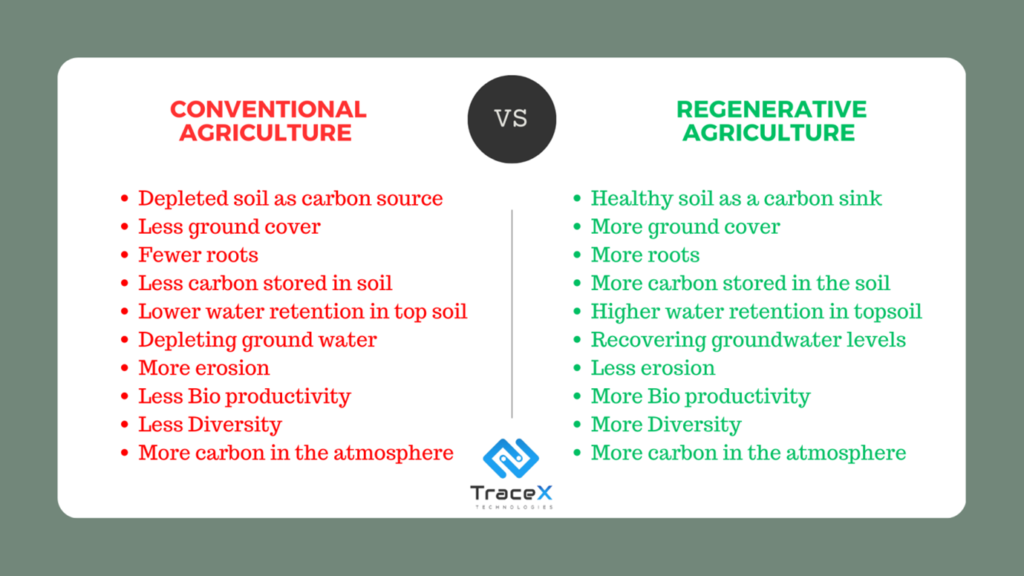Comparing Regenerative And Conventional Farming: Impact On Ecosystems Explained
Forestry expert sharing knowledge on sustainable land management.

Forestry expert sharing knowledge on sustainable land management.

Conventional farming prioritizes maximizing crop yields through methods like monoculture. It often leads to significant environmental challenges.
Monoculture involves cultivating a single crop across large areas. This practice severely degrades soil health, evident in declining fertility, topsoil erosion, and increased salinity.
The U.S. uses over one billion pounds of pesticides annually. These chemicals persist in nature and can build up in our bodies, causing chronic diseases and disrupting bodily functions.
A 2021 report by Chatham House reveals that global food systems are the primary driver of biodiversity loss. Heavy reliance on GMOs, monoculture, and intense pesticide use has drastically reduced flora and fauna diversity.
Intensive groundwater pumping is depleting groundwater reserves. Runoff from fertilizers and pesticides contaminates waterways and groundwater with harmful toxins, making human and animal health vulnerable.

Regenerative farming emphasizes a strong connection with the land, similar to restorative farming practiced by Indigenous cultures worldwide. It focuses on soil health to grow nutrient-rich crops holistically.
Regenerative agriculture prioritizes the microbiome in our soil. It honors the interconnected dynamics between soil, food, people, and livestock.
Instead of relying on chemical use and monocropping, regenerative agriculture uses crop rotation and cover cropping. Organic fertilizers are used to preserve the local ecosystem and biodiversity. You can learn more about it in this article: Farming Techniques That Revive Ecosystems and Boost Soil Health.
This approach preserves biodiversity above and below the soil. It emphasizes the responsible use of water and natural resources.
Regenerative farming focuses on working with natural systems instead of against them. This heals our soil and ecosystems and builds climate resilience in our communities.
Conventional agriculture has contributed to severe soil degradation. Continuous monoculture practices deplete soil nutrients, leading to declining fertility and significant topsoil loss.
Monoculture practices often result in increased soil salinity. This makes the land less suitable for a variety of crops and reduces overall agricultural productivity.
Agricultural runoff carries harmful chemicals into waterways and groundwater. This contamination poses risks to human health, aquatic life, and the overall ecosystem.
Intensive irrigation practices deplete groundwater reserves. This depletion threatens water availability for both agricultural and human use.
Conventional farming contributes significantly to greenhouse gas emissions. Activities such as fertilizer use and livestock management release substantial amounts of methane and nitrous oxide into the atmosphere.
The emissions from conventional farming practices contribute to global warming. This exacerbates climate change and its associated environmental impacts.
Monoculture and the use of genetically modified organisms (GMOs) reduce biodiversity. This simplification of ecosystems makes them more vulnerable to pests and diseases.
The decline in biodiversity negatively impacts pollinators, which are crucial for crop production. The overall health of ecosystems is compromised, affecting their ability to provide essential services.

Regenerative farming improves soil structure and fertility. Practices like cover cropping and no-till farming enhance the soil's ability to retain water and nutrients.
These practices enhance microbial communities in the soil. This leads to better nutrient cycling and healthier plant growth.
Regenerative farming reduces the use of chemical inputs. This minimizes the pollution of water sources from agricultural runoff.
Improved soil health enhances water infiltration and retention. This reduces the need for irrigation and helps conserve water resources.
Regenerative farming promotes a greater variety of plant and animal species. This biodiversity strengthens the resilience of agricultural ecosystems.
Creating diverse habitats supports wildlife and beneficial insects. This enhances pollination and natural pest control. It is essential to understand the negative impacts of deforestation on wildlife, as highlighted in this article: How Deforestation Hurts Wildlife: The Hidden Impact on Our Planet.
Regenerative practices sequester carbon in the soil. This reduces atmospheric CO2 levels and helps mitigate climate change.
Healthy soils and diverse ecosystems are more resilient to extreme weather. This helps farmers cope with the impacts of climate change.
Regenerative agriculture focuses on maintaining the long-term health of ecosystems. It ensures that farmland remains productive for future generations.
Conventional farming often prioritizes short-term yields at the expense of long-term ecological health. This approach can lead to significant environmental damage over time.
Regenerative farming aims to reduce reliance on external inputs like synthetic fertilizers and pesticides. It promotes the use of on-farm resources.
Conventional farming relies heavily on synthetic inputs and large amounts of water. This can lead to resource depletion and environmental degradation.
Regenerative farming may require a higher initial investment. However, it can lead to long-term profitability through reduced input costs and increased soil fertility.
Conventional farming often involves ongoing costs for synthetic inputs. Market fluctuations can also impact profitability.
Regenerative farming can strengthen communities by promoting local food systems and creating healthier environments. Urban farming projects are great examples of how agriculture can transform urban areas into thriving, sustainable communities.
Conventional farming can negatively impact rural economies by consolidating land ownership. It can reduce employment opportunities.

Farmers need to acquire new knowledge and skills to transition to regenerative practices. Educational programs and resources are essential for this shift.
Financial incentives and support can help farmers overcome the initial costs of transitioning. This includes grants, subsidies, and access to credit.
Certification programs can help farmers market their products as regeneratively grown. Access to markets that value these products is crucial.
Transitioning to regenerative farming may require changes in labor and operational practices. Farmers need to adapt their management strategies to incorporate new techniques.
Regenerative farming offers a sustainable alternative to conventional methods. It emphasizes soil health, biodiversity, and reduced reliance on external inputs.
Adopting regenerative practices is crucial for ensuring the long-term health of our ecosystems. It supports the sustainability of our food systems.
A paradigm shift towards regenerative agriculture is needed. It addresses environmental challenges and promotes a healthier planet for future generations.
Key Takeaways:
— in Travel and Nature
— in Sustainable Living
— in Wildlife Conservation and Deforestation
— in Sustainable Living
— in Sustainability and Carbon Offsetting